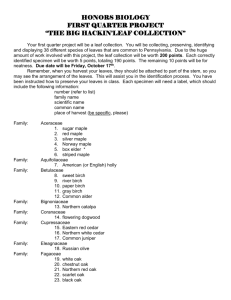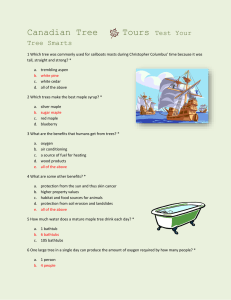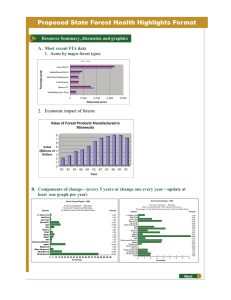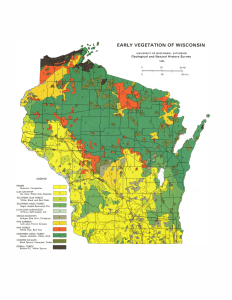Red Pine Composition: a in
advertisement
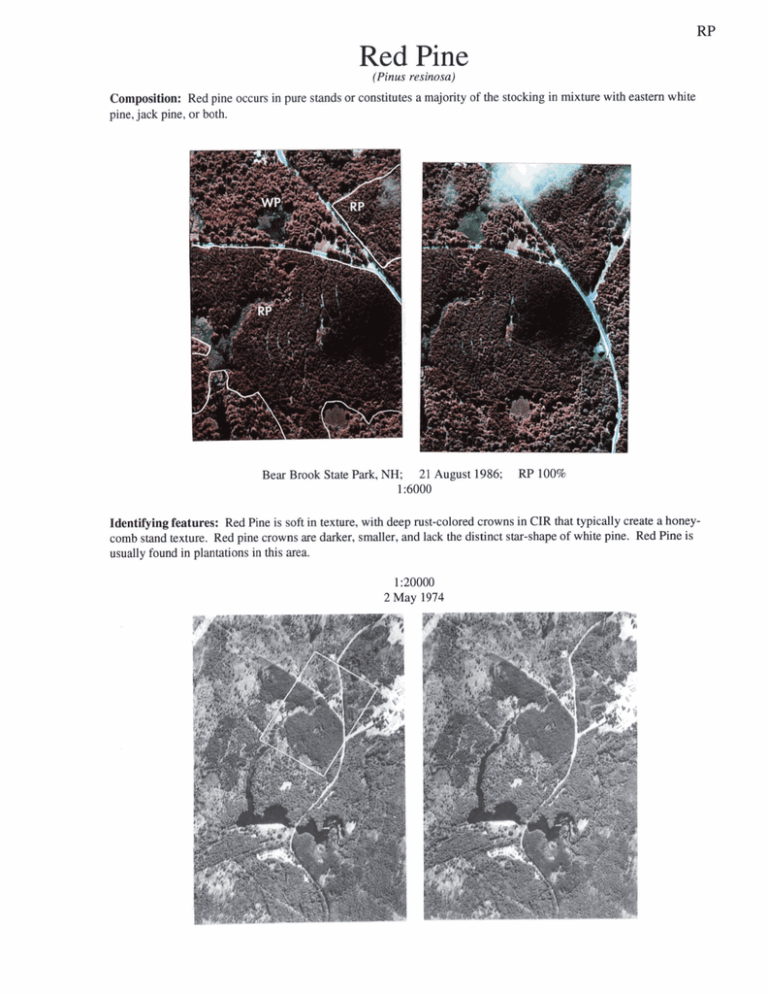
Red Pine Composition: Red pine occurs in pure stands or constitutes a majority of the stocking in mixture with eastern white pine, jack pine, or both. Bear Brook State Park, NH; 21 August 1986; 1:6000 RP 100% Identifying features: Red Pine is soft in texture, with deep rust-colored crowns in CIR that typically create a honeycomb stand texture. Red pine crowns are darker, smaller, and lack the distinct star-shape of white pine. Red Pine is usually found in plantations in this area. 1:20000 2 May 1974 RED PINE Ecological relations Relative values chsractrriziag the intensity of each factor at which a spacia prevails (1 =low. 5 = high) heat * w I -- I I Range of composition Common situation: Usually confined to poorer sites. such as small areas on ourwash plains or rocky mountain slopes. Usually found in plantations in this area. RP 75 50 Boundaries: Very distinct in plantations, merges with other pine types. Assodate species: Principally, white pine, jack pine (rarer in New England). On fine to loamy sands, red maple, red oak, white spruce, and balsam fir. On coarser, drier soil, aspen, white birch, and northern pin oak. Comparisons: In dense plantations, white pine may not have developed its distinctive star-shape. Red Pine's honeycomb stand pattern and darker color distinguish it from such stands of the White Pioe type. Compared with Pitch Pine, Red Pine is much less green in CIR. For a good color comparison between the pines, see Figure N. White Oak--Black Oak--Northern Red Oak (Quercus alba, Quercus velutina, Quercus rubra) Composition: White oak, black oak, and northern red oak together constitute a majority of the stocking. Bear Brook State Park, NH; 26 August 1986; WO 65%. BO 0%. RO 15% 1:6OW Identifying features: White Oak-Black Oak-Northem Red Oak may occur as large trees or as a scrub type. The type usually has a much whiter overtone than Red Oak as a result of the presence of white oak. Individual crowns are typically small but well defined, creating a fine, rough texture. WHITE OAK--BLACK OAK--NORTHERN RED OAK Geographic distribution in New England Ecological relations Relative values characterizing the mtensily of each factor at which a species prevails (1 =low, 5 =high) moisture 1 I 2 3 4 I I 1 5 I ............. heat Common situation: Occurs over a wide range of sites. White oak is present over the range of sites from moist to dry. Red oak is more prevalent on moistet sites, lower and middle slopes on north and east aspects in southern New England (and on south and west aspects from central NH north), coves, and benches with deep, welldrained loamy soils. Black oak is usually most abundant on the drier south and west aspects, upper slopes and ridges. Boundaries: Merges with adjacent types. Associate species: F'rincipally, yellow-poplar, sugar maple, red maple, white ash, green ash, American elm, basswood, pitch pine. Occasionally, black cherry, black walnut, beech, and hemlock Comparisons: If there is a large proportion of white oak in this type, it can be clearly distinguished from Red Oak by its much whiter color and less dense, less defined crowns. The scrub variety of this type is identified primarily by its much lower and sparser canopy. For an example of this variation, see Figure. U. White Pine--Red Oak-Red Maple (Pinus strobus, Quercus rubra, Acer rubrum) Composition: Eastern white pine and northern red oak are the most important species, although red maple is always present. Pawtuckaway State Park, NH; 21 August 1986; WP 35% RO 508, RM 5% 1:m Identifying features: White Pine--Red Oak--Red Maple is a broad type, varying widely in relative species composition. Texture is rough and fairly well defined, with the prominent, star-shaped white pine and the very hard-textured red oak. Crowns are generally large. Type color is variegated. The canopy may be solid and generally uniform, as in this example, or more open and uneven (refer to WP/RO/RM stand on Photo BSm. This example is shifted in color toward blue. In CIR,red oak is usually a stronger red and the white pine a lighter gray than shown here. 1:20000 24 October 1974 WHITE PINE--RED OAK--RED MAPLE Ecological relations Relative values chanrctcrizing the intensity of each factor at which each speciesprevails (1 = low,5 = high) moisture 1 I 2 I 3 4 1 I 5 I heat I "A Common situation: Occurs on fertile, well-drained sites. Often second growth on old fields. Boundaries: Usually indistinct, merging with adjacent, often similar, mixtures. Associate species: A major associate is white ash. Also common are eastern hemlock, yellow birch, white birch, black birch, black cherry, basswood, sugar maple, and beech. Comparisons: For more typical representation of the infrared color of this type, refer to the stand around the Black spruce and Black Spruce--Tamarack bog on page BSIT. The interpreter may have dficulty distinguishing a stand of primarily white pine and red maple from the White Pine-Hemlock type. The red maple is more orange and more intensely colored than hemlock, and forms a more defined crown. ( d d WP Range of , ,composition Red Spruce--Sugar Maple--Beech (Picea rubens, Acer saccham, Fagus grandifolia) Composition: Sugar maple and beech predominate in this type. Red spruce is a minor but characteristic component, forming 20 percent of the basal area and occasionally more. Conway State Forest, NH; 31 August 1986; 1:6000 RS 35% SM 10%. B 10% Identiming features: Red Spruce--Sugar Maple--Beech often makes a large, broad transition zone between Red Spruce and SM/B on the slope. Large dark lanceolate crowns amidst large pink billows identify the type in CIR. The canopy is relatively closed, except where terrain is very rough. 1:20000 28 October 1970 RED SPRUCE--SUGAR MAPLE--BEECH Geographic distribution in New England Ecological relations Relative values charactaizing the intensity of each factor at which each species prevails (I = low, 5 = high) heat I I I I 1 ................................................................................................ ................................................ light I I I I I Range of Common situation: Lower mountain slopes, upper hilly slopes, benches and gentle ridges. Boundaries: Merges gradually with adjacent types. Associated species: Often, balsam fir,hemlock, yellow birch, and red maple. Occasionally, black cherty, and white pine. 4 Comparisons: The crowns of this type are much larger than those of WB/RS/BF. 4 .
